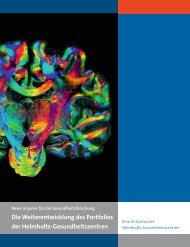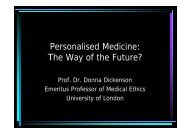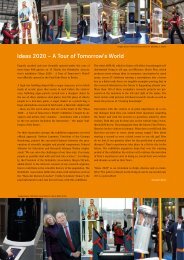Position Paper of Helmholtz Association of German Research ...
Position Paper of Helmholtz Association of German Research ...
Position Paper of Helmholtz Association of German Research ...
You also want an ePaper? Increase the reach of your titles
YUMPU automatically turns print PDFs into web optimized ePapers that Google loves.
<strong>Position</strong> <strong>Paper</strong> <strong>of</strong> <strong>Helmholtz</strong> <strong>Association</strong> <strong>of</strong> <strong>German</strong> <strong>Research</strong> Centres on<br />
Health Aspects in Horzion 2020<br />
2012
The <strong>Helmholtz</strong> <strong>Association</strong> <strong>of</strong> <strong>German</strong> <strong>Research</strong> Centres with its almost<br />
33,000 employees and an annual budget <strong>of</strong> 3.3 billion euros is <strong>German</strong>y’s<br />
largest research organisation and one <strong>of</strong> the largest in Europe. The<br />
<strong>Helmholtz</strong> <strong>Association</strong> participates in many European projects – <strong>of</strong>ten in<br />
a coordinating role – and benefits considerably from the established instruments<br />
<strong>of</strong> the Framework Programme <strong>of</strong> the European Union for <strong>Research</strong><br />
and Technological Development. The instruments and actions <strong>of</strong><br />
the Framework Programme contribute significantly towards supporting<br />
networking and collaboration between the scientists <strong>of</strong> the <strong>Helmholtz</strong><br />
<strong>Association</strong> and researchers throughout Europe. They facilitate as well<br />
activities which cannot be realised at the national level or which provide<br />
added value in the form <strong>of</strong> collaborations at the European level.<br />
1
Preamble<br />
The <strong>Helmholtz</strong> <strong>Association</strong> welcomes the stronger focus<br />
<strong>of</strong> EU funding programmes on societal challenges which<br />
raise complex scientific and technological questions. Supplementing<br />
the position papers <strong>of</strong> the <strong>Helmholtz</strong> <strong>Association</strong><br />
<strong>of</strong> <strong>German</strong> <strong>Research</strong> Centres on the 8th Framework<br />
programme <strong>of</strong> February 2010 1 and May 2011 2 , this position<br />
paper aims to contribute to the discussion on defining different<br />
challenges within Horizon 2020.<br />
According to the ongoing consultation and discussion process<br />
on “Horizon 2020 – The Framework Programme for<br />
<strong>Research</strong> and Innovation”, the following issues have been<br />
identified as major societal challenges:<br />
• Health, Demographic Change and Well-being<br />
• Food, Security and Sustainable Bio-resources<br />
• Secure, Clean and Efficient Energy<br />
• Smart, Green and Integrated Transport<br />
• Climate Action and Resource Efficiency<br />
• Inclusive, Innovative and Secure Societies<br />
• Future and Emerging Technologies<br />
• …<br />
To address these issues efficiently, concerted efforts by<br />
different stakeholders across Europe should be made. European<br />
aims and strategies should be formulated and implemented<br />
in collaboration with all relevant partners. The<br />
European Commission has already initiated the discussion<br />
process by organizing thematic workshops with stakeholder<br />
groups. We recommend continuing this approach in<br />
a more open, inclusive and transparent manner than has<br />
been previously been the case.<br />
Furthermore, the above-mentioned list <strong>of</strong> topics needs to<br />
be continuously reviewed and expanded as necessary. It is<br />
likely that some issues which have not yet been included<br />
or might emerge in the future could have a comparable<br />
and equally significant impact on society. There should be<br />
provisions for including such emerging issues in Horizon<br />
2020.<br />
The <strong>Helmholtz</strong> <strong>Association</strong> sees collaborative research as<br />
the most appropriate instrument to achieve these goals.<br />
Collaborative projects should therefore continue to be<br />
the backbone <strong>of</strong> all EU programmes for funding RTD and<br />
should be complemented by strategic partnerships bringing<br />
together European research organizations and institutes.<br />
<strong>Research</strong> infrastructures are another essential enabling<br />
platform in the innovation chain and should receive<br />
substantially more funding from the EU.<br />
1 <strong>Position</strong> paper <strong>of</strong> <strong>Helmholtz</strong> <strong>Association</strong> on the 8th EU Framework<br />
Programme (2014-2020), www.helmholtz.de/frp8-2010-en<br />
2 <strong>Position</strong> paper <strong>of</strong> <strong>Helmholtz</strong> <strong>Association</strong> on the Communication <strong>of</strong><br />
the European Commission “From Challenges to Opportunities: Towards<br />
a Common Strategic Framework for EU <strong>Research</strong> and Innovation” COM<br />
(2011) 48, www.helmholtz.de/greenpaper-2011-en<br />
Global Change – Challenges for the <strong>Research</strong><br />
and the Health System 3<br />
As a result <strong>of</strong> increasing life expectancies, the population<br />
<strong>of</strong> the EU is growing steadily older, and this demographic<br />
evolution presents a growing challenge to European society<br />
and European health systems.<br />
The increased life expectancy in the EU has come about<br />
through improved hygiene, healthier lifestyles and medical<br />
progress. However, the ageing process itself has not been<br />
significantly affected in the last hundred years. Thus, chronic,<br />
age-related diseases such as neurodegenerative diseases,<br />
cancer, cardiovascular and metabolic diseases like diabetes,<br />
as well as pulmonary diseases and related infections<br />
<strong>of</strong> immune-deficient patients are becoming increasingly<br />
important. Changes in lifestyle characterised by supernutrition<br />
and lack <strong>of</strong> physical activity, smoking and environmental<br />
stress have led to a strong increase in metabolic and<br />
pulmonary diseases, especially in the Western countries.<br />
Furthermore, global mobility facilitates the emergence <strong>of</strong><br />
new infectious diseases as well as the resurgence <strong>of</strong> those<br />
thought to be eradicated. The complex interaction <strong>of</strong> individual<br />
genetic disposition, lifestyle and environmental factors<br />
and their role in the development <strong>of</strong> disease is becoming<br />
an increasingly important focus <strong>of</strong> research. For example,<br />
the connection between metabolic syndrome, the result <strong>of</strong><br />
a complex metabolic failure, and widespread diseases like<br />
diabetes mellitus and cardiovascular and neuropsychiatric<br />
disorders is becoming more and more apparent.<br />
The maintenance and promotion <strong>of</strong> good health in European<br />
citizens as well as the prevention and targeted treatment <strong>of</strong><br />
diseases also represent major societal challenges. Since every<br />
person has a unique genetic disposition and reacts differently<br />
to environmental and lifestyle factors, personalised<br />
medicine is the only way to provide diagnostic methods and<br />
therapies that are safer and more effective and economical<br />
than conventional therapies.<br />
To meet these challenges successfully, substantial research<br />
efforts coordinated at the European level are required. One<br />
starting point is the understanding <strong>of</strong> molecular causes and<br />
pathogenetic mechanisms underlying diseases prevalent to<br />
modern civilisation, including the analysis <strong>of</strong> cell-specific<br />
pathways based on excellent fundamental, hypothesisdriven<br />
biomedical research as well as systems biology approaches<br />
analysing data and modelling pathological processes<br />
in biological systems.<br />
At the same time, new methods in research and development<br />
as well as the translation <strong>of</strong> results into clinical practice<br />
need to be developed further. This should proceed in<br />
two directions: Clinical experience should have an impact<br />
on research in the laboratory and vice versa.<br />
3 The recommendations in this document are based on internal discussions<br />
currently ongoing among in the <strong>Helmholtz</strong> Centres active in health<br />
research.<br />
2
Translational research is needed to accelerate the transfer<br />
<strong>of</strong> research results into clinical therapies for the benefit <strong>of</strong><br />
the patient and to realise the potential arising out <strong>of</strong> fundamental<br />
research through the development <strong>of</strong> clinical applications.<br />
Innovative medicine requires a long-term commitment<br />
<strong>of</strong> public fundamental research, market analyses,<br />
preclinical research, including research on animals, studies<br />
involving clinical partners and a long-term focus on attracting<br />
and integrating the pharmaceutical and medical<br />
devices industries in order to achieve the commercialisation<br />
<strong>of</strong> results.<br />
To unlock the enormous potential <strong>of</strong> scientific insights for<br />
the benefit <strong>of</strong> the patient, a concerted action <strong>of</strong> both national<br />
and European actors is vital.<br />
In the view <strong>of</strong> the <strong>Helmholtz</strong> <strong>Association</strong>, the following diseases<br />
<strong>of</strong> civilisation represent important research themes<br />
at the European level, including ageing processes and the<br />
ageing population as major cross-cutting themes relating<br />
to all other areas:<br />
• Cancer<br />
• Cardiovascular and metabolic diseases<br />
• Neurological diseases<br />
• Metabolic syndrome, especially diabetes mellitus<br />
• Infectious diseases<br />
• Lung diseases and allergies<br />
Prevention is a key issue that needs to be improved in order<br />
to ensure the financial stability <strong>of</strong> our health care systems<br />
over the long term. Insights gained from epidemiological<br />
studies can provide the basis for better prevention, diagnosis<br />
and therapy. In the view <strong>of</strong> the <strong>Helmholtz</strong> <strong>Association</strong>,<br />
studies based on prospective and population-based cohorts<br />
and the implementation <strong>of</strong> biomaterial banks provide an<br />
important foundation for research in the above-mentioned<br />
areas.<br />
Disease-related topics<br />
Cancer<br />
The <strong>Helmholtz</strong> <strong>Association</strong> is convinced that development<br />
<strong>of</strong> new approaches to cancer diagnosis and treatment can<br />
be improved by innovative strategies based on research<br />
and development at the molecular, cellular and immunological<br />
level. Therefore, research in these areas needs to be<br />
strengthened. Medical technologies such as development<br />
<strong>of</strong> new imaging methods and strategies for radiotherapy,<br />
which make possible early detection and prevention, play<br />
an important role as well. Therefore, the main topics in cancer<br />
research should include:<br />
• Signaling and proteomics in cancer cells<br />
• Cancer induction<br />
• Metabolic syndrome and cancer<br />
• Health economy in the context <strong>of</strong> oncological diseases<br />
• Personalised radio-oncology and ion therapy<br />
• Radiopharmacy and molecular imaging<br />
• Precision <strong>of</strong> radiotherapy<br />
Cardiovascular and metabolic diseases<br />
Cardiovascular diseases represent the most frequent cause<br />
<strong>of</strong> death in the Western industrial countries, with a steady<br />
upward trend. The main risk factors are high blood pressure,<br />
metabolic syndrome, in particular diabetes mellitus,<br />
increased levels <strong>of</strong> blood lipids, adiposity and tobacco consumption.<br />
To achieve a significant, steady decrease in the incidence<br />
<strong>of</strong> these diseases and to counteract the consequences <strong>of</strong><br />
demographic change, there must be large-scale efforts to<br />
elucidate the causes <strong>of</strong> these diseases. New approaches relating<br />
to the prevention, diagnosis and treatment <strong>of</strong> cardiovascular<br />
and metabolic diseases are required which should<br />
be based on a variety <strong>of</strong> methodological approaches in genetics,<br />
genomic research and systems biology, cell biology<br />
and epidemiology. Along these lines, important research<br />
topics include:<br />
• Immune system and cardiovascular diseases<br />
• Non-coding RNAs<br />
• Role <strong>of</strong> metabolism for the prediction, prevention<br />
and course <strong>of</strong> disease<br />
• New animal models for diseases and development<br />
<strong>of</strong> adequate methods for phenotyping<br />
• Cardiac development and congenital heart defects<br />
• Cardio-metabolic diseases and multimorbidity<br />
in old age<br />
• Drug research<br />
• Health economics in the context <strong>of</strong> cardiovascular<br />
diseases<br />
Neurological diseases<br />
With increasing age, the risk <strong>of</strong> neurological and psychiatric<br />
diseases increases. The main risk factors are age and<br />
chronic diseases such as diabetes, depression and cardiovascular<br />
diseases. Genetic analysis and epigenetic studies<br />
help to clarify the link between risk factors and neurodegenerative<br />
processes. Epilepsies, brain tumours or cognitive<br />
impairments following strokes also play an important<br />
role. <strong>Research</strong> into their causes, diagnosis, treatment and<br />
prevention is therefore essential.<br />
In this context, a better understanding <strong>of</strong> molecular, cellular<br />
and systemic mechanisms and structures in the human<br />
brain is required. For successful implementation, transgenic<br />
animal models as well as research in genetics, cell biology,<br />
neurophysiology, neuroanatomy and high-performance<br />
3
scientific computing are necessary. Moreover, methodological<br />
approaches such as structural and functional imaging,<br />
brain mapping and the “virtual brain” should be supported.<br />
All <strong>of</strong> these methods and approaches can form a basis for<br />
better health care delivery and prevention in this area.<br />
Therefore, key research topics should include:<br />
• Neurodegeneration, neuroprotection and<br />
neuroregeneration<br />
• Signal mechanisms<br />
• Animal models for neurodegenerative diseases<br />
• Risk factors: ageing and co-morbidity<br />
(e. g., metabolic syndrome)<br />
• Translational, diagnostic and functional imaging<br />
• Epidemiological and population studies<br />
• Health care systems and delivery<br />
• Clinical research and intervention studies<br />
Infectious diseases<br />
Infectious diseases are still the third most frequent cause<br />
<strong>of</strong> death worldwide and will continue to be a serious threat<br />
to humanity. Although antibiotics and vaccines have been<br />
developed and hygienic measures improved, we are constantly<br />
confronted with new or recurring pathogens that at<br />
one time appeared to be under control. The increasing resistances<br />
<strong>of</strong> pathogens to common antibiotics and the facilitation<br />
<strong>of</strong> transmission <strong>of</strong> infectious agents through factors<br />
such as globalisation and climate change in combination<br />
with an ageing population make prevention and therapy<br />
<strong>of</strong> infectious diseases a huge challenge. This becomes particularly<br />
obvious through epidemic outbreaks <strong>of</strong> previously<br />
unknown diseases like SARS, bird and swine flu.<br />
In addition, well-known pathogens can become more aggressive<br />
as a result <strong>of</strong> mutations. This was the case with<br />
the recent EHEC/HUSEC epidemic in <strong>German</strong>y. Therefore,<br />
the development <strong>of</strong> new methods for diagnosis, prevention<br />
and therapy <strong>of</strong> infectious diseases based on fundamental<br />
research into molecular processes like the interactions <strong>of</strong><br />
between pathogens and infected hosts is essential to combat<br />
these threats. New anti-infection and immune therapies<br />
must be developed to counteract the problem <strong>of</strong> increasing<br />
resistance and the decreasing number <strong>of</strong> potent antibiotics.<br />
Therefore, the main issues to be addressed are:<br />
• <strong>Research</strong> on new and emerging infectious diseases<br />
• Identification <strong>of</strong> new active substances to overcome<br />
pathogen resistance<br />
• <strong>Research</strong> on host-pathogen-interactions<br />
• Infection and age<br />
• Nosocomial infections<br />
• Diagnostics for personalised therapies<br />
• Sequelae <strong>of</strong> infectious diseases<br />
(cancer, metabolic dysfunction, neurodegeneration)<br />
• Chronic infections<br />
• Immune modulation and intervention to combat<br />
infectious diseases<br />
• Functional and integrative genomic research<br />
combined with<br />
• Systems biology for a better understanding <strong>of</strong><br />
infection processes and drug functions<br />
Health and environment with a particular focus<br />
on pulmonary diseases and diabetes<br />
Chronic pulmonary diseases, diabetes, neuropsychiatric<br />
diseases, cardiovascular failures, allergies, and cancer are<br />
the result <strong>of</strong> a complex interplay <strong>of</strong> genetic factors, environment<br />
and personal life style. To develop strategies for<br />
personalised prevention, early detection and therapy, the<br />
interplay <strong>of</strong> body and environmental factors needs to be explored.<br />
In addition, their role in maintaining health, their<br />
influence on the development <strong>of</strong> diseases as well as on the<br />
effectiveness <strong>of</strong> therapeutic interventions also needs to be<br />
investigated. An important related issue involves the influence<br />
<strong>of</strong> climate change on health. The entire organism and<br />
the ensemble <strong>of</strong> complex internal interactions should be<br />
observed through the use <strong>of</strong> systemic approaches. Fundamental<br />
biomedical research can contribute towards elucidating<br />
issues relating to such widespread diseases as neuropsychiatric<br />
diseases, infectious diseases, cardiovascular<br />
diseases, allergies and cancer.<br />
Priorities in translational research in these areas should<br />
comprise pulmonological and diabetes research. Pulmonary<br />
diseases represent the second most frequent cause<br />
<strong>of</strong> death worldwide, with smoking being one <strong>of</strong> the main<br />
causes along with other factors. The development <strong>of</strong> new<br />
approaches for prevention and diagnosis is urgently needed,<br />
as well as therapies tackling the cause and symptoms<br />
<strong>of</strong> the disease.<br />
<strong>Research</strong> on diabetes should forge new paths comprising an<br />
integrative research approach that combines various scientific<br />
disciplines like genetics, epidemiology, immunology,<br />
stem cell research and many other subdisciplines. Only in<br />
this way can a comprehensive understanding <strong>of</strong> this complex<br />
disease be achieved that will result in completely new<br />
therapeutic, diagnostic and preventive approaches.<br />
Therefore, the main issues to be addressed are:<br />
• Environmental factors and epigenetics<br />
• Stress and environment as risk factors<br />
• Systemic analysis <strong>of</strong> active substances<br />
• Metabolism and the neuroendocrinological axis<br />
• Human microbiome<br />
• Health care delivery and health economics<br />
• Interaction <strong>of</strong> ageing, environmental factors<br />
and the genome<br />
• Multiple exposures in urban environments<br />
and chronic diseases<br />
• Medical radiation research<br />
4
• Pulmonary diseases (pathological mechanisms,<br />
signalling pathways, etc.)<br />
• Allergy research<br />
Cross-cutting topics and methods<br />
Prevention and early detection<br />
Prospective epidemiological studies are regarded as the<br />
gold standard in the identification <strong>of</strong> genetic and environmental<br />
risk factors, that determine the onset and progress<br />
<strong>of</strong> disease. Since many widespread diseases can be detected<br />
solely at the advanced stage, it is necessary to improve<br />
health care delivery through new approaches to early detection<br />
and prevention. By providing tangible benefits for<br />
patients, these approaches can provide considerable potential<br />
for economising in our health care system. Therefore,<br />
appropriate studies should be designed and implemented<br />
through a Europe-wide network to make such research possible.<br />
Personalised Medicine<br />
Often, medical therapies are not effective or cause serious<br />
side effects. Therapeutic decision-making does not sufficiently<br />
take into account certain characteristics <strong>of</strong> the<br />
respective disease, individual genetic constitution, gender,<br />
age and co-morbidity <strong>of</strong> the patient, although these<br />
factors considerably influence whether the therapy has<br />
a successful outcome or not. To make treatments more effective,<br />
safer and more economical, personalised medicine<br />
aims to develop new preventive and therapeutic strategies<br />
which can be adjusted to the requirements <strong>of</strong> the defined<br />
group <strong>of</strong> patients. The factors which influence therapeutic<br />
decision-making must be identified and further elucidated<br />
and developed through research. In this context, research<br />
on biomarkers and a speedy transfer into diagnostics and<br />
clinical application are essential.<br />
New model systems for diseases and<br />
optimisation <strong>of</strong> pre-clinical research<br />
To carry out a comprehensive analysis <strong>of</strong> systemic diseases<br />
such as cardiovascular and metabolic diseases, optimised<br />
model systems (complex cell culture systems, animal models)<br />
are still required because already existing models are<br />
<strong>of</strong>ten deficient with respect to predictability or because <strong>of</strong><br />
side effects in humans. The development <strong>of</strong> adequate methods<br />
for phenotyping is also necessary to provide new insights.<br />
Along these lines, new transgenic techniques and<br />
new research methods should be established to optimise<br />
pre-clinical research.<br />
Active substances and structural biology<br />
Innovative approaches for the identification <strong>of</strong> small molecules<br />
with effects on biological systems are becoming increasingly<br />
important for biomedical research and form a<br />
basis for a targeted and quick development <strong>of</strong> secure and<br />
affordable pharmaceutical agents. To expedite the translation<br />
<strong>of</strong> active substances into applications, interdisciplinary<br />
approaches and shared chemical-biological platforms<br />
with relevant test procedures are needed. The basis for the<br />
strategic development <strong>of</strong> new therapeutic agents depends<br />
on generating and exchanging new knowledge among different<br />
areas like structural biology, in silico modeling, in<br />
vitro screening and in vitro design. This approach should<br />
be accompanied by the systematic analysis and optimisation<br />
<strong>of</strong> bioactivity in models and the development <strong>of</strong> clinical<br />
applications. New methods such as defining spatial<br />
structures <strong>of</strong> biomolecules in solution make it possible to<br />
observe dynamic effects and biological regulatory mechanisms<br />
and can help gain new insights into metabolic processing.<br />
Metabolomics and chemical biology establish new<br />
competencies that are helpful in developing close collaborations<br />
between research institutions and industry.<br />
Imaging<br />
Functional characterisation <strong>of</strong> tissue plays a major role in<br />
investigating complex systems as well as in the diagnosis<br />
and individualised treatment <strong>of</strong> cancer and other diseases<br />
such as cardiovascular, pulmonary, psychiatric and<br />
neurological diseases. Molecular imaging and methods<br />
for the analytical interpretation <strong>of</strong> images combined with<br />
high-throughput analysis should be developed further.<br />
This includes improvement <strong>of</strong> nuclear medicine imaging<br />
methods (especially PET), development <strong>of</strong> new approaches<br />
in magnetic resonance tomography, quantitative real-time<br />
multispectral optoacoustic tomography (MSOT) as well as<br />
the development and establishment <strong>of</strong> high-resolution optical<br />
methods like Stimulated Emission Depletion (STED)-<br />
microscopy and fluorescence tomography (FMT) associated<br />
with development <strong>of</strong> combined procedures (multimodal<br />
imaging). All <strong>of</strong> these include as well the development <strong>of</strong><br />
molecular and nanoscale probes based on radiotracers,<br />
fluorescent markers and MR-contrast agents.<br />
Health economics<br />
Along with clinical efficacy, long-term cost effectiveness is<br />
a key success factor in innovative approaches in prevention,<br />
diagnosis and therapy. The possible economic implications<br />
<strong>of</strong> the innovative and individualised approaches<br />
require comprehensive analysis, and appropriate research<br />
in these areas should therefore be supported.<br />
5
<strong>Research</strong> infrastructures<br />
<strong>Research</strong> infrastructures (RI) represent an effective means<br />
<strong>of</strong> creating platforms for scientific collaboration and research<br />
networks. Moreover, as they provide methods and<br />
resources for research and development in biomedical<br />
research, RIs are essential for exploiting the full potential<br />
<strong>of</strong> translational research because they establish links<br />
between scientists carrying out fundamental and clinical<br />
research and physicians in clinical settings. (Laboratory g<br />
Clinic, Clinic g Laboratory). Moreover, RIs facilitate links<br />
between scientific research and the education and training<br />
<strong>of</strong> young researchers as well as their involvement in international<br />
research collaborations. Therefore, it is essential<br />
to provide support for the design, implementation and operation<br />
<strong>of</strong> RIs in Horizon 2020.<br />
Transfer <strong>of</strong> research results into innovation<br />
Successful transfer <strong>of</strong> research results into the pharmaceutical,<br />
biotechnological and medical device industries is<br />
a key indicator for effective translation. Chemical biology<br />
and drug research play an important role in transferring research<br />
results into the pharmaceutical industry by increasing<br />
the value <strong>of</strong> academic research and making it attractive<br />
for industry. Strategic partnerships between industry and<br />
academia, licensing or spin-<strong>of</strong>fs can contribute to shortening<br />
the length <strong>of</strong> time needed to transfer innovative ideas<br />
for clinical application into the market and generating new<br />
impulses for innovation and growth in the health industry.<br />
Clinical applications based on new insights relating to e.g.<br />
new prognostic markers have an important impact because<br />
they provide immediate help to patients or to physicians<br />
making treatment decisions.<br />
6
Brief portrait <strong>of</strong> the <strong>Helmholtz</strong> <strong>Association</strong><br />
In the <strong>Helmholtz</strong> <strong>Association</strong>, 18 <strong>German</strong> research centres have joined forces to share their resources in<br />
strategically oriented programmes to investigate complex questions <strong>of</strong> societal, scientific and technological<br />
relevance.<br />
They concentrate on six major research areas: energy; earth and environment; health; aeronautics, space<br />
and transport; key technologies and structure <strong>of</strong> matter. The scientists work closely together across the<br />
centres on these issues.<br />
The <strong>Helmholtz</strong> <strong>Association</strong> provides the necessary resources, a framework for long-term planning, a high<br />
concentration <strong>of</strong> scientific competence and an outstanding scientific infrastructure with major projects,<br />
some <strong>of</strong> which are unique worldwide.<br />
The research objectives <strong>of</strong> the <strong>Helmholtz</strong> <strong>Association</strong> are set by the funding bodies after discussions with<br />
the <strong>Helmholtz</strong> centres and the <strong>Helmholtz</strong> Senate and Assembly <strong>of</strong> Members. Within this framework, the<br />
scientists <strong>of</strong> the <strong>Helmholtz</strong> centres determine the themes <strong>of</strong> their research through strategic programmes<br />
in the six research areas across centres.<br />
(Source: “Strategy <strong>of</strong> the <strong>Helmholtz</strong> <strong>Association</strong>,” Berlin 2009 - updated 2012)<br />
www.helmholtz.de<br />
<strong>Helmholtz</strong> Centres<br />
▪▪<br />
▪▪<br />
▪▪<br />
▪▪<br />
▪▪<br />
▪▪<br />
▪▪<br />
▪▪<br />
Alfred Wegener Institute for Polar und Marine <strong>Research</strong><br />
Deutsches Elektronen-Synchrotron DESY<br />
<strong>German</strong> Cancer <strong>Research</strong> Center<br />
Deutsches Zentrum für Luft- und Raumfahrt<br />
Deutsches Zentrum für Neurodegenerative Erkrankungen<br />
Forschungszentrum Jülich<br />
GEOMAR | <strong>Helmholtz</strong> Centre for Ocean <strong>Research</strong> Kiel<br />
GSI <strong>Helmholtz</strong> Centre for Heavy Ion <strong>Research</strong><br />
▪ ▪ <strong>Helmholtz</strong> Centre Potsdam GFZ, <strong>German</strong> <strong>Research</strong> Centre for Geosciences<br />
▪▪<br />
▪▪<br />
▪▪<br />
▪▪<br />
<strong>Helmholtz</strong> Centre for Environmental <strong>Research</strong> – UFZ<br />
<strong>Helmholtz</strong> Centre for Infection <strong>Research</strong><br />
<strong>Helmholtz</strong>-Zentrum Berlin für Materialien und Energie<br />
<strong>Helmholtz</strong>-Zentrum Dresden-Rossendorf (HZDR)<br />
▪ ▪ <strong>Helmholtz</strong>-Zentrum Geesthacht Centre for Materials and Coastal <strong>Research</strong><br />
▪▪<br />
▪▪<br />
▪▪<br />
▪▪<br />
<strong>Helmholtz</strong> Zentrum München, <strong>German</strong> <strong>Research</strong> Center for Environmental Health<br />
Karlsruhe Institute <strong>of</strong> Technology<br />
Max Delbrueck Center for Molecular Medicine (MDC) Berlin-Buch<br />
Max Planck Institute for Plasma Physics (associated member)
This paper presents a consensus <strong>of</strong> the views<br />
<strong>of</strong> the <strong>Helmholtz</strong> <strong>Association</strong> and its centres.<br />
Please direct further questions and comments to:<br />
Dr. Susan Kentner<br />
susan.kentner@helmholtz.de<br />
Dr. Karin Lohmann<br />
karin.lohmann@helmholtz.de<br />
<strong>Helmholtz</strong> <strong>Association</strong> Brussels Office<br />
Rue du Trône 98<br />
B -1050 Brussels, Belgium<br />
www.helmholtz.de/en<br />
Cover image: European Parliament, Brussels. Copyright: <strong>Helmholtz</strong> <strong>Association</strong>
















